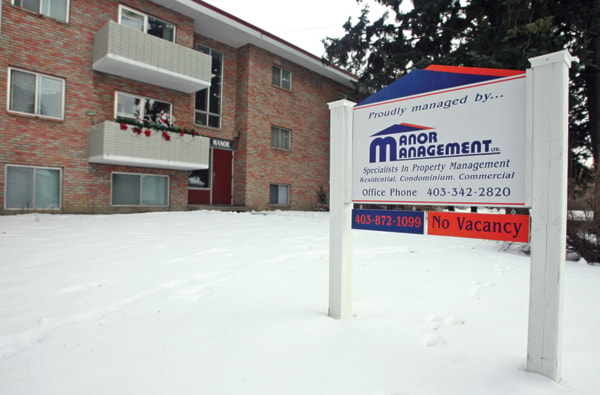A sharp drop in apartment vacancy rates in Red Deer could soon translate into rental hikes, says a market analyst with Canada Mortgage and Housing Corp.
Regine Durand was commenting on CMHC’s fall rental market survey, the results of which were released on Tuesday. These indicated that the average vacancy rate in the city in October was 3.2 per cent, down from 7.5 per cent a year earlier.
In the case of two-bedroom units, which are the most common type of apartment, the year-over-year drop was to 3.9 per cent from nine per cent. The average vacancy rate for bachelor suites declined to 0.4 per cent from 9.4 per cent, one-bedroom apartments went to 2.5 per cent from 5.1 per cent, and units with three or more bedrooms slipped to 3.6 per cent from 5.9 per cent.
The majority of Red Deer’s nearly 4,500 rental apartments are one- and two-bedroom units, noted Durand.
She said the in-migration of people to Alberta and Central Alberta contributed to the reduced vacancy rates, as did job gains — including about 2,700 in Red Deer — during the past year.
Despite the tighter rental market, the average monthly cost for apartments of all types in October was $764 — down $6 from the same month in 2010.
The CMHC survey found that the average rent for two-bedroom units increased slightly, to $823 from $817. But average rents were down in every other category: bachelor units declined to $548 from $592, one-bedrooms slipped to $696 from $706, and suites with three or more bedrooms dipped to $916 from $933.
Durand said these numbers probably reflect the previous weak rental market, as well as the movement of many people from rental accommodation to home ownership. But CMHC doesn’t expect this situation to last.
“We do anticipate vacancies to keep moving lower, and with that we expect to see a slight increase in rents.”
CMHC also provided rental market statistics for Sylvan Lake and Lacombe.
The average vacancy rate in Sylvan Lake jumped to five per cent in October, up from 0.9 per cent a year earlier. In Lacombe, the October 2011 number was 5.7 per cent, down from 11.6 per cent.
The CMHC survey also found that the average rent in Sylvan Lake in October was $799, up from $692. In Lacombe, there was a year-over-year increase to $732 from $718.
Durand suggested that a movement of many people from rental accommodation to home ownership contributed to Sylvan Lake’s higher vacancy rate this fall. And the relatively small number of rental units in the town might have skewed its rental averages, she added.
CMHC conducts a rental market survey every spring and fall. Its earlier 2011 survey, completed in April, found that the average vacancy rate in Red Deer dropped to 6.4 per cent from 8.7 per cent the previous spring. The average rent in April was $767, down from $787 in April 2010.
The most recent survey found a vacancy rate of 3.4 per cent among the 17 Alberta communities with population of more than 10,000. That’s down from 4.6 per cent in October 2010.
Medicine Hat and the Regional Municipality of Wood Buffalo had the highest vacancy rates, at 9.4 per cent; Okotoks and Canmore had the lowest vacancy rates, at zero.
The highest average rent was $1,949 in Wood Buffalo, and the lowest was $663 in Medicine Hat.
hrichards@www.reddeeradvocate.com
